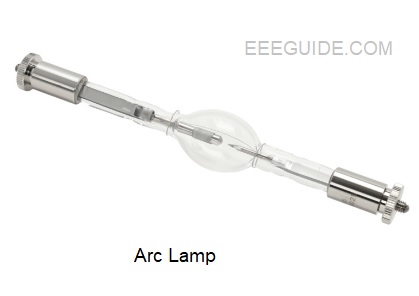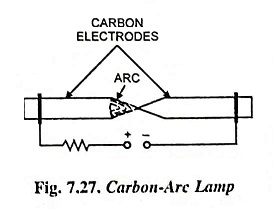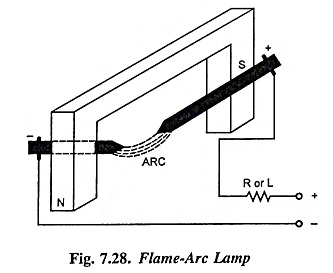Arc Lamp -Definition, Working Principle and Types:
In an arc lamp electric current is made to flow through two electrodes in contact with each other which are drawn apart. The result is an arc being struck. The arc maintains the current, and is very efficient source of light.
Types of Arc Lamps:
Three types of Arc Lamps are namely
- Carbon Arc Lamp
- Flame Arc Lamp
- Magnetic Arc Lamp
Carbon Arc Lamp:
This is earliest type and is still used in cinema projectors and search lights. When two hard carbon rods are placed end to end and connected to the terminals of dc supply mains of not less than 45 volts, the current flows through them and the ends of carbon rods soon become incandescence due to high resistance. If they are slightly pulled {say about 2 or 3 mm) an are will be formed between two carbon rods and white light will be produced. The arc is maintained by transfer of carbon particles from one rod to another one. It is found that these particles travel from the positive carbon rod to negative one. That is why, the positive rod after sometime of use becomes hollow and negative becomes a pointed pencil.
Due to transfer of particles and oxidation both rods burn away by and by. The rate of burning of positive rod is twice of that of negative rod, that is why, the x-section of the positive rod is made twice of that of negative one. In case of ac supply the rate of burning of both rods is same and, therefore, they are made of equal x-section. Since the carbon is consumed during operation, therefore, requires adjustment of distance between two rods now and then. Except in small lamps, an automatic device is required for feeding the carbon into the arc as they burn away. The voltage required for maintaining the arc is given approximately by V = (39 + 2.8 l) where l is the length of the arc in mm.
The carbon arc is unstable, since as the current increases the amount of vaporised carbon increases, and the resistance decreases so much that the product of current and resistance, i.e., the voltage drop across the arc falls. A series resistance is, therefore, used for stabilising the arc, and this leads to a low overall luminous efficiency. The voltage drop across the arc is about 45 to 60 volts and the supply voltage is about 70 to 100 volts. In case of ac supply an inductor is used in place of series resistance for stabilising the arc.
In a carbon-arc lamp about 85% of light is given out by the positive carbon, 10% by the negative carbon and 5% by the air. The temperature of positive carbon is between 3,500°C and 4,000°C and that of negative one is about 2,500°C. The luminous efficiency of such a lamp is 12 lumens per watt.
Flame Arc Lamp:
The principle of operation is similar to that of carbon-arc lamp. The electrodes of such a lamp has 5 to 15% fluoride (called the flame material) and 85 to 95% carbon. Generally core type carbon electrodes are used and the cavities are filled with fluoride. The fluoride has a characteristic which radiates light energy efficiently from a very high heated arc stream. Fluoride turns into vapour along with the carbon and these fluoride vapours cause a very high luminous intensities. In addition to fluoride, there are also other some flame materials. Different flame materials will produce different colours. Most of these colours do not appeal to eyes and at the same time they produce strain on them. The arc can be drawn out to one side with the help of a magnet. Though the arc is very efficient but owing to objection to its colours it has now been superseded by the electric discharge lamps. The luminous efficiency of such a lamp is 8 lumens per watt.
Magnetic Arc Lamp:
In such a lamp positive electrode made of copper and negative electrode made of magnetic oxide of iron are used. The arc is struck in the similar way as in case of carbon-arc lamp. Such lamps are rarely used.


